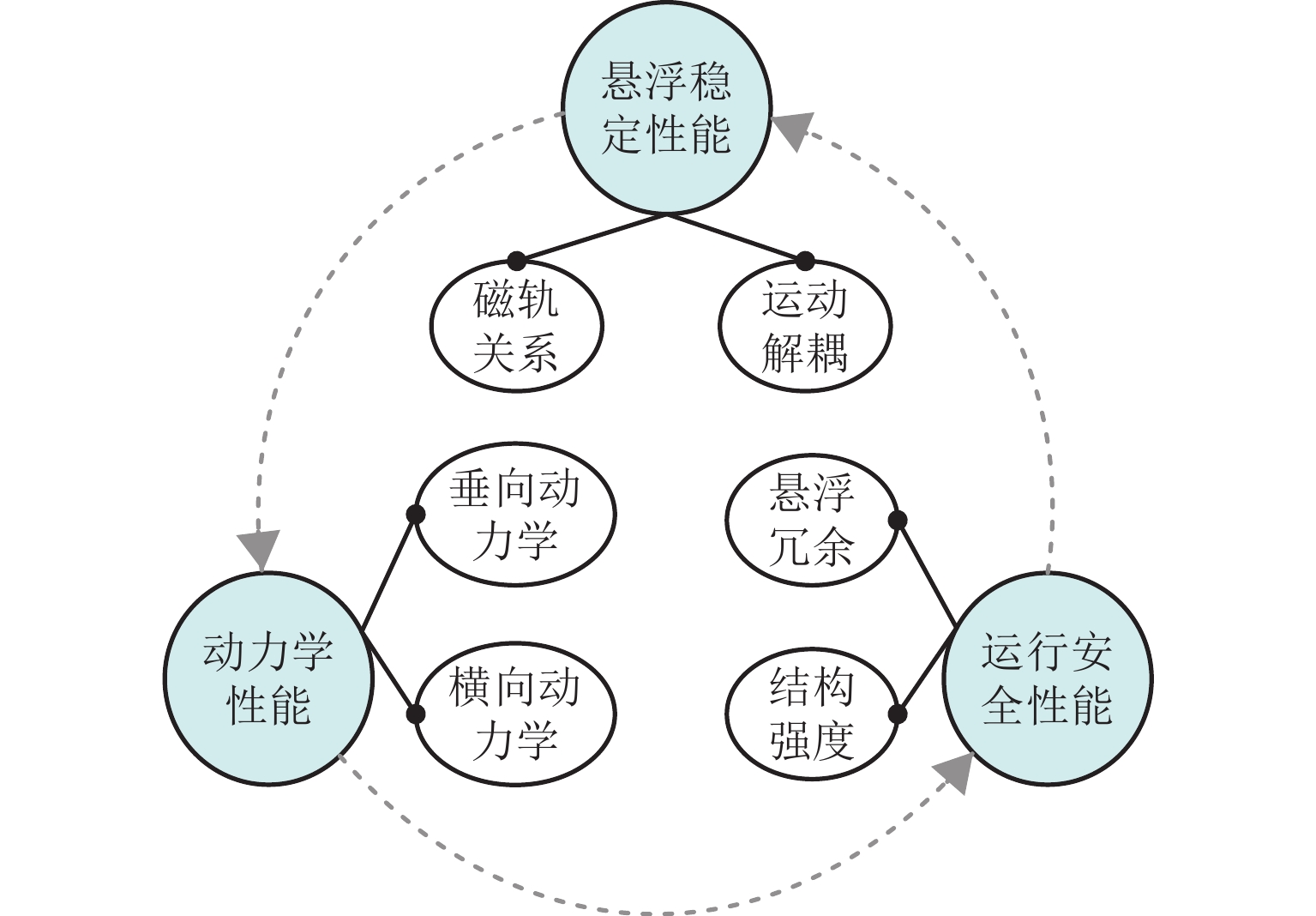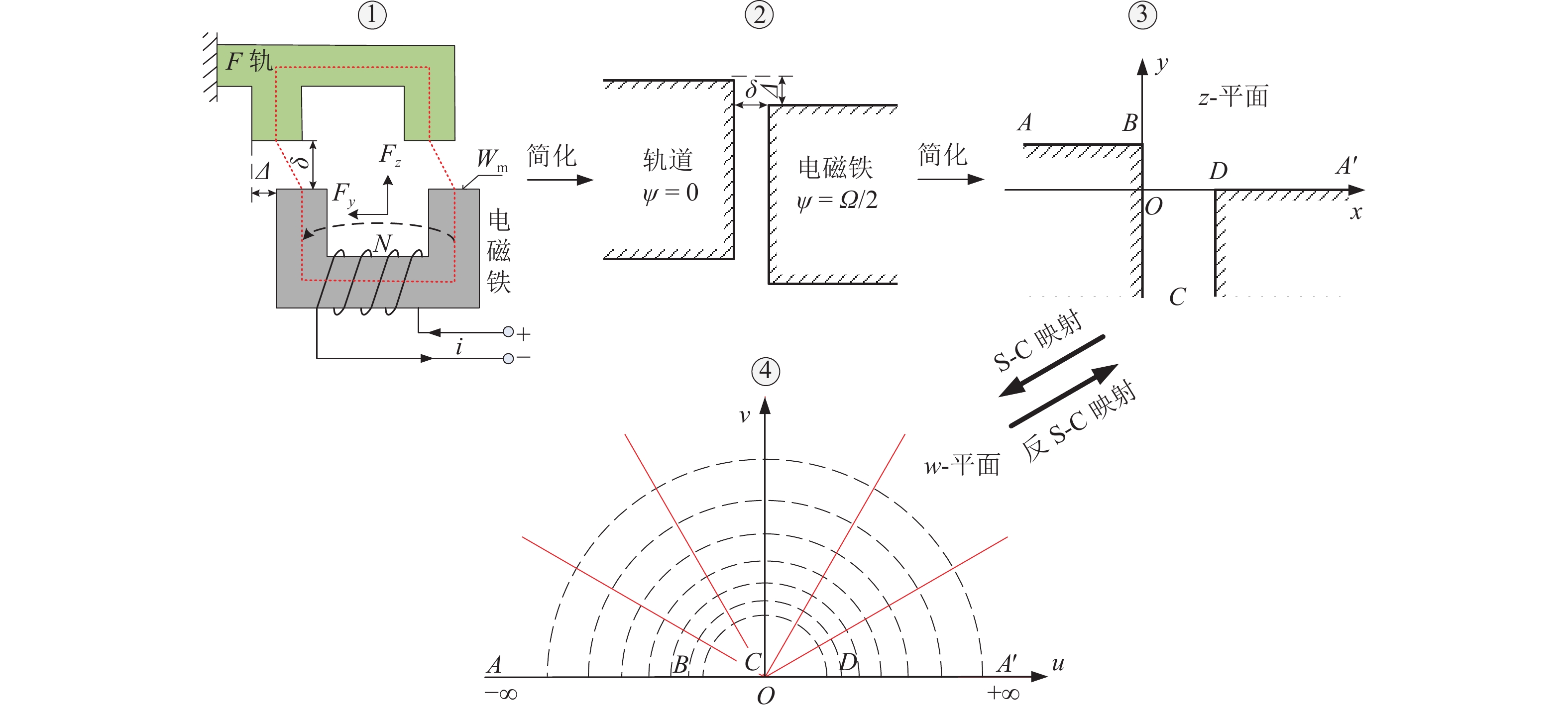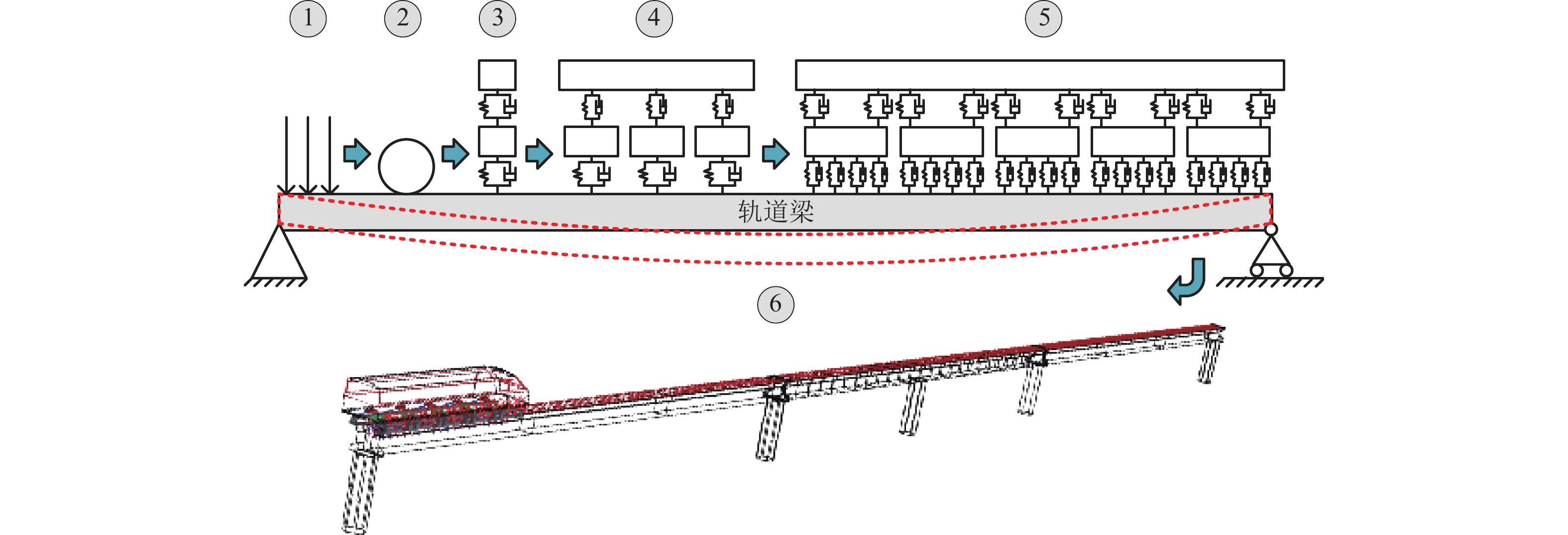Technologies Research Review of Electro-Magnetic Suspension Medium−Low-Speed Maglev Train Levitation Frame
-
摘要:
悬浮架是承载EMS(electro-magnetic suspension)型中低速磁浮列车运行的关键子系统,影响列车的悬浮稳定性、舒适性和安全性,需要对其进行深入研究. 围绕国内外EMS型中低速磁浮列车应用案例,介绍了(悬挂)端置式悬浮架、(悬挂)中置式悬浮架的技术方案和特征,总结了主要技术指标. 结合悬浮架技术研究、发展现状,讨论了磁轨作用关系、运动解耦能力、动力学性能、结构强度以及悬浮冗余设计五大研究方向,通过对研究内容梳理和总结,归纳了现有前沿科学问题和工程技术挑战:一是轨距亟须统一;二是动态磁轨关系研究欠缺;三是悬浮架横向动力学有待研究;四是悬浮架疲劳强度分析及试验不足;五是悬浮架机械结构冗余设计方案较少.
Abstract:The levitation frame is a key subsystem that carries EMS (electro-magnetic suspension) medium−low-speed maglev trains, which affects the levitation stability, comfort and safety of the train and needs to be studied in depth. According to domestic and overseas current application cases of EMS medium-low speed maglev trains, the technical solutions, and characteristics of (suspension) end-set levitation frame and (suspension) mid-set levitation frame are concluded, and the key technical indexes are summarized. With the combination of current research and development status of levitation frame technologies, the five major technical research contents which are magnetic-rail interaction relationship, motion decoupling capability, dynamics performance, structural strength and levitation redundant design are discussed. In addition, the existing frontier scientific issues and engineering challenges are summarized by sorting out and summarizing the research contents: first, the track gauge should be unified; second, the dynamic magnetic-rail relationship research is lacking; third, the lateral dynamics of levitation frames needs to be studied; fourth, the fatigue strength analysis and test of the levitation frame is insufficient; fifth, the levitation frame mechanical structure redundant design scheme is less.
-
磁浮的概念早在1842年由英国物理学家Earnshow首次提出,德国科学家Hermann Kemper在1937年获得了磁浮列车专利,阐述了磁浮列车的原理和概念. 在随后的几十年时间里,德国、日本、韩国、中国等国家相继对磁浮列车进行了大量的研发和试验,逐步掌握了目前几个具有代表性的磁浮列车技术. 从悬浮原理上分,磁浮列车有电磁悬浮(EMS)、电动悬浮(EDS)、高温超导钉扎悬浮(HTS)、永磁悬浮(PMS)以及电磁永磁混合悬浮(HEMS)5种,其中电动悬浮又分为永磁电动悬浮及超导电动悬浮. 从最大运用速度上分有中低速磁浮(≤160 km/h)、中速磁浮(160~300 km/h)、高速磁浮(300~600 km/h)以及超高速磁浮(≥600 km/h)等[1-4]. 现阶段仅有EMS型中低速和高速磁浮列车技术实现了商业运用.
EMS型中低速磁浮列车依靠常导电磁铁实现悬浮和导向,并采用短定子直线感应电机牵引,适用于速度不高于200 km/h的城市、城际交通运输[5],相较于地铁、轻轨等城市轨道交通,其具有振动及噪音低、爬坡能力强、转弯半径小、绿色环保等优势,是一种应用前景良好的新型轨道交通工具[6-7].
日本是最早开始中低速磁浮列车技术研发的国家,并在2005年开通了全球首条商业运营线——东部丘陵线TKL (Tobu Kyuryo Line),该线包括1.4 km隧道和7.5 km高架,共设站9座. 运行在TKL线上的中低速磁浮列车Linimo由Mc1-M-Mc2三节车辆编组而成(Mc为端部带司机室的动车,M为中部动车),最高运行速度100 km/h,自动驾驶运营[8-9]. 韩国、中国等国家也积极开发了多款试验车并修建了试验线,逐步掌握了中低速磁浮列车技术. 2016年韩国开通了仁川机场中低速磁浮商业线,该线路全长6.1 km,设站6座,运行列车Ecobee由Mc1-Mc2两节编组而成,最高运行速度100 km/h[10].
中国在2016年和2017年先后开通了长沙磁浮机场线以及北京磁浮S1线,其中长沙机场线全长18.55 km,全程高架敷设,共设站3座,预留站2座. 列车为Mc1-M-Mc2三节编组形式,最大运行速度达到140 km/h[11]. 北京磁浮S1线全长10.2 km,包含9.95 km高架和0.28 km隧道,共设站7座,列车为Mc1-M-M-M-M-Mc2六节编组,最高运行速度120 km/h[12]. 2022年5月,国内首条旅游观光磁浮快线凤凰磁浮开通运营,线路全长9.12 km,共设站4座,预留站2座. 列车为Mc1-M-Mc2三节编组,最高运行速度100 km/h. 此外,国内清远磁浮及长沙机场磁浮东延线正在施工建设,长沙—宁乡、长沙—浏阳磁浮项目已获批待建.
EMS型中低速磁浮列车主要由走行机构、车体、牵引系统、悬浮控制系统、制动系统、列车通信系统等组成. 置于车体底部的若干悬浮架共同构成列车的走行机构,其功能类似于轮轨列车的走行部,为列车提供支撑、导向、牵引和制动等作用[13],是一大核心子系统.
EMS型中低速磁浮列车尚处于推广应用阶段,存在较多的技术方案. 本文总结了当前典型的中低速列车悬浮架技术特征,结合悬浮架研究、发展现状综述了主要研究内容,并提出了需要深入研究的前沿科学问题和工程技术挑战.
1. 悬浮架技术特征
1.1 (悬挂)端置式悬浮架
20世纪70年代初,受到德国TR (transrapid)高速磁浮列车技术的启发,日本开始研究应用于城市短途运输的中低速磁浮技术HSST (high speed surface transport),旨在设计新一代陆上快速交通工具. 早期的HSST系统悬浮架采用U型电磁铁悬浮模块,配备短定子直线感应电机,但由于缺少结构间的运动解耦及悬挂系统,实际效果并不理想[14]. 此后,经过长期的试验研究和改进,形成了性能可靠的(悬挂)端置式悬浮架,并沿用至今. 韩国仁川机场磁浮列车Ecobee以及中国长沙机场磁浮列车、北京S1线磁浮列车均采用了类似HSST列车的悬浮架技术.
(悬挂)端置式悬浮架将悬浮和导向系统整合为一体,利用固结在悬浮架上的电磁铁与F型铁磁轨道间的电磁吸力实现车辆的悬浮与导向,借助短定子直线感应电机牵引. 如图1所示,悬浮架可分为左、右悬浮模块,每个悬浮模块均具备悬浮、导向、牵引和制动作用. 左、右悬浮模块由两套特殊设计的防侧滚梁装置连接并实现运动解耦,悬浮架整体呈“口”字形. 在两侧悬浮模块的端部各布置有1个空气弹簧作为悬挂系统,滑台则坐落在相邻悬浮架的空气弹簧上,共同承担车体重量. 此外,悬浮架与车体间布置有迫导向机构,辅助各悬浮架通过小半径曲线弯道.
1.2 (悬挂)中置式悬浮架
为解决EMS型中低速磁浮列车的车-桥耦合振动问题,西南交通大学轨道交通运载系统全国重点实验室常导磁浮技术团队提出了(悬挂)中置式悬浮架方案,沿用了(悬挂)端置式悬浮架的悬浮、导向和牵引原理,同时进行了结构创新. 如图2所示,两种悬浮架最大的差异体现在左、右悬浮模块的连接以及空气弹簧的布置形式两方面.
首先,(悬挂)中置式悬浮架将防侧滚梁装置减少为一套,布置在悬浮架中部,整体呈“工”字形. 该项改进提高了左、右悬浮模块的解耦能力,从而提升了悬浮稳定性,同时一定程度上实现了结构的简化. 其次,(悬挂)中置式悬浮架取消了原四角倒扣布置小空气弹簧的悬挂方案,改为在悬浮模块中部布置2个大空气弹簧.
从悬浮架点头运动克服空气弹簧力做功的角度分析,中置空气弹簧方案能够降低悬浮系统的调整能量,从而改善车-桥耦合振动问题[15];同时还释放了直线电机的纵向空间,通过增加直线电机长度,减小端部效应,可以提高悬浮架的牵引能力. 此外,由于中置式大空气弹簧相比原方案倒扣的小空气弹簧能够提供更大的水平刚度,因此取消了悬浮架与车体之间的迫导向机构,试验验证了50 m半径小曲线弯道通过能力,此改动进一步简化了车辆结构.
表1总结了既有EMS型中低速磁浮列车的主要技术指标,可以看出性能指标主要差异在于最高运行速度. 将EMS型中低速磁浮列车提速到中等速度可以拓宽适用范畴,增加市场竞争力. 不过车载短定子直线感应电机的牵引能力有限,需要提高牵引功率和效率,长沙磁浮新增列车经过牵引系统优化后将最高运营速度从110 km/h提升至140 km/h. “十三五”中速磁浮列车子任务研发的200 km/h中速磁浮列车则采用了轨道侧长定子同步直线电机驱动. 此外,中低速磁浮列车提速后带来的车-桥耦合振动问题、靴-轨受流稳定性问题值得关注和研究.
表 1 EMS型中低速磁浮列车主要技术指标Table 1. Main technical indexes of EMS medium-low speed maglev train项目 轨距/mm 最高运行速度/
(km·h−1)最大爬坡
能力/‰最小曲线
半径
/m编组 单节车悬
浮架数量列车全长/m TKL磁浮 1700 100 70 50 3 5 43.3 仁川磁浮 1850 100 70 50 2 4 25 长沙磁浮 1860 140 70 50 3 5 48.3 北京磁浮 2000 120 70 50 6 5 89.6 (悬挂)中置式磁浮 1900 160 70 50 3 5 48.2 表1中还值得关注的是国内中低速列车技术存在1860、1900、2000 mm 3种轨距,磁浮交通与既有轮轨交通线路缺乏通用性是制约其推广应用的因素之一,轨距不统一则进一步限制了自身技术的适用性. 从工程案例分析,国内除了北京磁浮S1线外,已商业运营的长沙磁浮机场线和凤凰磁浮旅游线以及正在修建的清远磁浮旅游线、长沙磁浮机场线东延线均采用了1860 mm轨距. 长远来看,后续开发项目宜沿用1860 mm轨距,相关单位需制定标准对轨距进行约束.
2. 悬浮架相关技术研究与挑战
悬浮架的作用类似轮轨列车的转向架,关系到中低速磁浮列车的悬浮稳定性能、动力学性能以及运行安全性能,且三者之间相互关联和影响. 针对这三大性能研究的主要内容如图3所示,磁轨关系是所有研究工作的基础,运动解耦研究则为了保证每个悬浮控制单元尽可能独立,从而更稳定地悬浮. 动力学性能研究可分为垂向和横向,垂向动力学研究重点在于车-桥耦合振动这一特殊问题,横向动力学研究集中在曲线通过方面. 运行安全性能研究包括悬浮架结构静强度和疲劳强度以及设计悬浮冗余方案等内容.
2.1 磁轨作用关系
磁轨作用关系是指悬浮电磁铁极板与轨道磁极之间的作用规律,是研究EMS型中低速磁浮列车悬浮控制策略及整车动力学的基础,受到材料、结构参数、线圈匝数、作用位置等因素的影响[16].
电磁铁与轨道之间的相互作用力是一个三维分布力,其解需要通过椭圆积分求得. 早期研究中把磁轨作用力简化成定常力或线性弹簧阻尼力[17], 如式(1).
F=F0+keqδ+ceq˙δ, (1) 式中:F0为额定电磁力(N);keq为等效弹簧刚度(N/m);ceq为等效弹簧阻尼(Ns/m);δ为电磁铁距轨道间隙(m).
式(1)在悬浮间隙波动不大时具有一定的计算精度,当间隙变化范围较大时不再适用. 式(2)为另一种电磁力经典计算公式,在EMS型磁浮列车悬浮系统分析中应用得更加广泛[18-19].
F=μ0N2A4(iδ)2, (2) 式中:μ0为真空磁导率(N/m2);N为电磁铁线圈匝数;A为磁极面积(m2);i为电磁铁电流(A).
式(2)在诸多假设条件下成立,只能计算一维均布电磁力,对于磁通饱和以及漏磁严重等情况下不再适用. Braezina和Langerholc[20]在开发德国早期EMS型磁浮列车时, 率先开展了平面状态下复杂磁轨作用关系的研究,通过合理的简化避开了求解椭圆方程以及椭圆积分问题,推导出电磁垂向力和侧向力. 赵春发等[21]进一步针对EMS型低速磁浮车辆的导向特性开展研究,基于电磁铁二维磁力分析,得到了垂向悬浮力(式(3))和横向力(式(4)).
Fz=2F[α(Δ+ay,δ)+α(Δ−ay,δ)], (3) Fy=2F[β(Δ+ay,δ)+β(Δ−ay,δ)], (4) 式中:Δ为电磁铁横向初始错位量(m);ay为电磁铁横向位移(m);α(y,δ)=1+2zπWm−2yπWmtan−1yδ,y为电磁铁相对F轨的横向错位量(m),Wm为电磁铁磁极宽度(m);β(y,δ)=2zπWmtan−1yδ.
式(3)比式(1)、(2)计算结果更为精确,式(4)体现了横向力因素,在动力学模型中通过式(3)、式(4)来表达磁轨作用关系是合适的.
二维磁轨关系的计算过程如图4所示,对二维磁轨作用模型 ① 进行简化得到单个磁极的作用关系②,使用复变函数u=f(z)=ϕ+jψ描述z平面中的磁场分布,磁势Ω=NI,ψ为磁位(复平面z=x + jy,x轴为实轴,y轴为虚轴),得出化简后的两角模型 ③,④ 是两角模型的求解原理,使用保角变换(S-C映射)将z平面上的磁场映射到w平面,在已知w平面磁场分布的前提下可以通过S-C反映射得到z平面的磁场分布. 谢云德、常文森[22]运用类似原理推导出电磁铁在较大滚动条件下的垂向力、横向力以及滚动力矩的计算方法.
上述一维、二维磁轨作用关系的推导均是基于开环、静态条件下进行的,无法反映实际运动状态下的电磁铁悬浮特性. Yamamura和Ito[23]分析了运动电磁铁在纵向和横向上的二维磁通密度分布规律,推导了移动电磁力的计算模型,得到了速度-电磁力的作用关系. Onuki等[24-25]结合有限元法和边界元法对移动电磁铁的涡流磁场分布规律进行了分析,并进而研究了电磁铁横向错位布置时电磁铁-轨道之间的磁场分布. 李云钢和常文森[26]从电磁铁的侧向力计算公式出发,对EMS型中低速磁浮列车电磁铁横向错位布置形成的导向模型进行研究,尝试利用侧向加速度进行主动反馈控制. Zhao等[27]对磁轨动态作用力进行分析,推导出悬浮平衡点位置的等效悬浮刚度和等效悬浮阻尼的近似表达式,为建立线性悬浮系统的EMS型磁浮列车/车辆整车动力学模型提供了理论依据. 洪华杰和李杰[28]则从稳定性、动态响应特征以及高频激励响应3个方面讨论了等效弹簧阻尼与实际控制系统的差别,认为二者之间并不等效. 梁鑫等[29-30]建立了考虑微小波动时的单电磁铁悬浮系统动态数学模型,研究了车辆在运行过程中的动态磁轨作用关系.
现阶段对于磁轨作用关系的研究还不够成熟,缺乏系统的研究成果,实际三维状态下磁轨作用力尚未见到报道,因而目前对于EMS型磁浮列车动力学研究中依然需要将电磁悬浮力进行简化或等效.
2.2 运动解耦能力
EMS型中低速磁浮列车采用分散控制方案,每个悬浮架四角各设置了一个悬浮控制单元. 从三点决定一个平面可知,必须解耦左、右悬浮模块才能保证4个悬浮控制单元同时稳定悬浮. 悬浮架的解耦能力是影响悬浮系统稳定性与车辆运行平稳性的重要因素之一,因此,研究悬浮架的运动解耦能力是十分必要的.
悬浮架防侧滚梁装置的作用是解耦左、右悬浮模块之间的运动关系,确保每个悬浮控制单元尽可能独立运动,从而保证悬浮稳定性. 防侧滚梁安装座固定在悬浮模块内侧面,通过2个关节轴承连接片梁,2个吊杆再通过关节轴承将左、右片梁连接起来. 关节轴承释放了旋转自由度,悬浮模块与片梁之间以及片梁和吊杆之间均可相对摆动. 落车时由于吊杆的约束,又可防止悬浮模块侧滚.
悬浮架是一个多刚体结构,无论内部组件如何相对运动,其几何尺寸及相对位置关系不会改变. 基于此背景, 赵志苏等[31-32]建立了EMS型中低速磁浮列车和高速磁浮列车悬浮架的运动学方程式,为分析悬浮架各部件的运动规律提供了理论基础. 图5分别是(悬挂)端置式悬浮架和(悬挂)中置式悬浮架受到垂向激扰时的解耦运动姿态.
以图5(a)(悬挂)端置式悬浮架为例来解释悬浮架运动解耦机理,图中悬浮架结构尺寸符号的含义及数值如表2所示. 由于片梁与悬浮模块之间只有旋转自由度,左、右片梁之间的z向位移自由度也由吊杆互相耦合,因而左、右悬浮模块之间的z向运动解耦将通过片梁及吊杆的摆动来实现位移补偿. 具体地,当右侧悬浮模块的悬浮控制单元受到z向激扰d时,右悬浮模块会绕y轴点头运动,片梁和悬浮模块之间以及片梁与吊杆之间的关节轴承处于一个不稳定状态. 右侧的片梁(11、21)和吊杆(R1、R2)跟随悬浮模块z向移动的同时还会分别绕z轴和y轴摆动,左侧片梁(12、22)和吊杆(L1、L2)跟随摆动,z向竖直的吊杆由于摆动运动而倾斜,从而补偿了左侧片梁和悬浮模块的z向位移,即实现了左、右悬浮模块的运动解耦.
表 2 (悬挂)端置式悬浮架特征尺寸Table 2. Technical parameters of levitation frame with end-set airspring符号 定义 尺寸/mm Lm 悬浮模块长度 2720 Lg 轨距 1860 Larb 片梁长度 1030 l 吊杆距片梁安装座距离 226 Lpdl 吊杆长度 200 X 悬浮控制单元距防侧滚梁距离 273 基于此模型,文献[33-34]对(悬挂)端置式悬浮架和(悬挂)中置式悬浮架的运动解耦能力进行了解析分析,得出了两种悬浮架的悬浮模块、片梁以及吊杆的理论姿态,讨论了防侧滚梁布置位置、片梁及吊杆等结构尺寸对悬浮架解耦能力的影响. 也有学者运用机器人运动学研究方法分析悬浮架各部件的运动姿态:张耿等[35]采用D-H变换,推导了悬浮架正向运动学方程和运动学逆解,结合轨道平曲线参数,计算了吊杆在平曲线上的运动情况,并提出悬浮架实现解耦的条件;Leng等[36]提出一种基于螺旋理论和指数映射理论的低速磁浮列车悬浮架运动学建模、求逆解的分析计算方法.
除了机械结构解耦外,也可以从悬浮控制的角度出发,在控制律中引入解耦矩阵来实现悬浮控制单元之间的电气解耦:刘德生等[37]建立了单侧悬浮模块的数学模型,分析悬浮模块运动耦合的本质,提出了悬浮模块电气解耦算法;蒋启龙等[38]定性和定量分析了悬浮架传感器信号之间的耦合关系,计算不同情况下的耦合强度;Zhang等[39]建立了线性化状态反馈控制系统模型,研究了悬浮架单模块的解耦控制问题;He等[40]提出了一种悬浮系统解耦的控制方法,并验证了控制系统的鲁棒稳定性和解耦设计方法的有效性;Leng等[41]设计出一种基于反馈线性化理论的解耦控制器,并通过仿真和实验证明该控制器具有良好的解耦效果.
左、右悬浮模块解耦越充分越有利于稳定悬浮,不过由于防侧滚梁装置约束较少,某EMS型中低速磁浮列车在试验时监测到吊杆出现晃动,甚至碰撞片梁产生噪音. 另外,每个悬浮控制单元不是同步落车时可能导致左、右悬浮模块纵向错位,此时片梁、吊杆会产生大位移甚至干涉,存在安全隐患. 未来需要对防侧滚梁装置进一步优化,比如在片梁与吊杆之间增加弹性限位等措施.
2.3 动力学性能
悬浮架的功能类似于轮轨列车转向架,因而会影响EMS型中低速磁浮列车的动力学性能. 由于悬浮系统的非线性特性,以及悬浮间隙仅为8~10 mm,导致了特殊的车-桥耦合振动问题[42],因此EMS磁浮列车动力学研究时多会考虑弹性轨道梁因素,所建立的动力学模型也经历了由简到繁的过程,如图6.
图6中 ①~③ 为早期阶段,此时动力学建模常将列车简化为移动荷载、移动质量、质量-弹簧振子等,轨道梁采用Bernoulli-Euler梁模型,主要研究轨道梁结构参数变化、挠跨比、刚度等因素对系统动力学性能的影响. 随着研究的深入,④、⑤ 所示的车体、悬浮架等主要部件的运动自由度以及弹性悬挂系统逐步被引入磁浮车辆动力学模型中. Popp等[43-44]指出车辆动力学模型应包含体、铰、弹簧、阻尼以及执行器等部分,并介绍了简化磁浮车辆动力学建模方法. 由于悬浮力为面作用力,在进行动力学建模时需将其简化为若干集中力,文献[45]对比分析了集中力个数的影响,认为将每个模块的悬浮力简化为4个集中力即可满足精度要求.
对于建立多自由度的2D平面动力学模型,通常考虑悬浮架和车体的浮沉、点头运动,借助多体系统动力学建模理论、方法能够较为方便地建立其动力学方程,然后编写仿真计算程序进行数值求解[46]. Zheng等[47]将磁浮车辆简化为具有两级悬挂共5自由度的多体模型,仿真分析了是否考虑车辆-桥梁耦合振动时的系统动力响应. 曾佑文等[48-49]在研制中国早期CFC磁浮列车时建立了磁浮车辆-轨道梁垂向耦合动力学方程,模型中包含车体、悬浮模块等7个刚体共35个自由度,悬浮系统采用线性弹簧-阻尼,对车辆、轨道梁不同参数下的动力响应特征进行了比较分析.
技术的发展和进步使得磁浮车辆动力学模型趋于精细化和复杂化,逐渐发展到图7中 ⑥ 所示的3D动力学模型,对编写动力学方程及计算程序提出了较高的要求. 借助专业软件建立基本完整的磁浮车辆-桥梁耦合系统动力学模型更加方便. 文献[50]指出分析磁浮车辆-悬浮控制-桥梁耦合系统的详细动力学行为一般有两种方法:其一是借助Adams,SIMPACK等动力学软件与ANSYS等有限元软件进行联合建模仿真;其二是开发更高效的磁浮车辆-悬浮控制-桥梁动力学专用仿真程序, 并以TR08高速磁浮车辆为对象,基于MATLAB平台开发了3D磁浮车辆-悬浮控制-桥梁耦合动力学仿真程序,对车辆、桥梁振动进行了仿真分析. Min等[51]也进行了类似的研究,建立了UTM磁浮试验车3D动力学模型并编写了计算程序进行仿真分析.
利用动力学软件进行动力学建模和仿真更为方便. Han等[52-53]基于Virtual Lab. Motion分析程序建立了3D磁浮车辆-桥梁耦合动力学模型,仿真分析了不同轨道梁的动力学响应,其研究成果对轨道梁挠跨比限值这一关键指标的选取具有参考意义. Hu等[54]则介绍了一种利用SIMPACK软件的铁路模块、控制模块以及有限元模块联合建立3D中低速磁浮车辆-悬浮控制-弹性桥梁耦合动力学模型的方法. 俄罗斯布良斯克国立工程大学计算力学实验室在其多体动力学软件UM (universal mechanism)中率先开发了磁浮列车模块,吸引了部分磁浮列车动力学研究学者的使用[55].
上述介绍的关于悬浮架或EMS型中低速磁浮整车动力学的研究基本都是垂向动力学性能. 事实上不论何种悬浮原理的磁浮列车处于悬浮状态时在横向都会通过各种技术途径来保持稳定,不过在小半径曲线通过、轨道梁横向振动、强横向力作用等情况下会存在横向动力学问题. 当前对EMS型中低速磁浮列车横向动力学的研究远没有垂向动力学研究成果丰硕,既有研究在于为列车、线路设计合理的参数和结构形式,从而提高列车曲线通过的能力.
EMS型中低速磁浮车辆没有设置专门的导向电磁铁,小曲线通过时各悬浮架受到的横向载荷不平均,为此日本HSST磁浮车辆在车体与悬浮架之间设置了两套迫导向机构,原理如图7所示. 该机构主要由长T型臂、短T型臂、横拉杆、钢缆等组成. 长、短T型臂的中心销接在车体纵向中心线上,可相对车体转动. T型臂一端通过横拉杆与滑台连接,两根钢缆分别连接在长、短T型臂的另一端,构成一个平行四边形结构. 车体与2、5位滑台固定连接,因此2、5位左右滑台的连线与车体中心线的交点即为磁浮车辆的固定转心,从而可以得到任意时刻车体及悬浮架在曲线上的位置. 曲线通过时由于各悬浮架相对车体横向移动量不同,将迫使T型臂绕其销轴转动,进而通过钢缆带动另一悬浮模块相对车体发生转动,从而可以将未平衡离心力、风载等横向力平均分配到各个悬浮模块的悬挂系统上. 韩国、中国开通运营的中低速磁浮列车都采用了该方案.
对EMS型中低速磁浮列车曲线动力学行为的研究主要包括迫导向机构的作用机理和姿态、导向力、电磁铁和车体横动量等内容来评估列车的曲线通过能力:Hosoda等[56]对HSST-03试验车通过250 m半径曲线时的横向位移、横向力等参数进行了动力学仿真以及试验验证;卜继玲等[57]根据早期CFC磁浮试验车技术特点建立了动力学模型,仿真分析了磁浮车辆通过300 m半径曲线时的动态响应;Zhao等[58]对CFC低速磁浮车辆的导向方式及特性进行研究,并建立相应的动力学模型仿真分析了不同速度通过不同半径曲线的安全性问题;叶学艳等[59]针对CFC低速磁浮车辆建立了包含主动反馈控制的磁浮车辆动力学模型,仿真分析了300 m半径曲线通过时迫导向机构的运动状态;Yim等[60]以UTM-02磁浮列车为原型建立含状态反馈控制的动力学模型,讨论了电磁铁不同布置方式、相邻悬浮架之间通过不同方式耦合连接等情况下列车曲线动力学响应.
EMS型中低速磁浮列车横向动力学问题不止于曲线通过行为. 从磁轨作用关系部分的介绍可知列车的导向力与垂向悬浮力是耦合的,理应存在横向振动和稳定性问题,目前的研究尚未涉及此处. 事实上,某EMS型中低速磁浮列车线路试验时在特定速度下会出现横向振动突然加剧现象,可能与轨道梁的横向振动有关.
2.4 结构强度分析
EMS型中低速磁浮列车悬浮架主要由纵梁、托臂、托臂连接件、防侧滚梁、停放制动滑橇等组成,是悬浮电磁铁、直线电机定子等的安装基础,承受着列车运行过程中的悬浮力、牵引力和制动力,悬浮架的结构强度关系到列车的运行安全. 此外,由于电磁悬浮能力有限,包括悬浮架在内的结构轻量化设计一直是EMS型中低速磁浮列车的一大技术挑战. 悬浮架结构需要满足强度要求的同时尽可能实现轻量化,故而大量使用了密度低、强度高的铝合金材质,并进行结构拓扑优化设计,表3是(悬挂)中置式悬浮架的主要结构信息.
表 3 悬浮架主要结构材料及工艺Table 3. Main structural materials and process of levitation frame部件 材料 密度/(kg·m−3) 质量/kg 成型工艺 纵梁 6061 2800 110.39 挤压+机加工 托臂 ZL204A 2810 32.36 铸造+机加工 上托臂连接件 ZL204A 2810 29.42 铸造+机加工 下托臂连接件 ZL204A 2810 25.95 铸造+机加工 滑台 ZL204A 2810 26.10 铸造+机加工 牵引座 Q235 7850 4.57 拼焊+机加工 片梁 Q235 7850 16.96 激光切割+机加工 吊杆 Q235 7850 1.00 机加工 悬浮架需要通过静强度、疲劳强度、模态分析等过程来评估是否满足安全要求,评价指标一般为最大等效应力不超过材料屈服强度、应力与应力幅在疲劳极限内、悬浮架自振频率要远离悬浮及悬挂系统固有频率等. 当前对于悬浮架结构强度分析、评定规范或标准较为欠缺,因而没有统一的分析工况及方法:杨磊和赵志苏[61]参考了轮轨车辆转向架的工况载荷,对悬浮架静强度进行了校核;周益等[62]根据第四强度理论,选用Von Mises等效应力进行强度校核,分析了悬浮、制动、落车3种工况下的静强度.
进行悬浮架结构强度分析时要考虑边界条件的特殊性,例如悬浮状态下悬浮架相对于轨道处于一个弹性约束状态,采用位移固定约束可能导致应力偏大;纵向冲击或加速状态时悬浮架不是静态,其约束边界不易施加,可以考虑使用惯性释放等虚拟约束措施,用结构的惯性力平衡外力,能够得到更为真实的应力分布.
相较于结构静强度,对悬浮架进行疲劳强度研究需求更为迫切. 早在20世纪初期人们就从轮轴断裂事故开始认识到疲劳问题,目前轮轨交通、公路交通及航空领域结构疲劳强度分析较为成熟,从形成机理、仿真方法到试验设备等方向的研究都趋于精细化. EMS型中低速磁浮列车悬浮架主体结构采用了铝合金铸造或挤压成型,零部件之间大量采用了栓接、焊接工艺,长期在复杂的服役环境下可能诱发裂纹甚至产生脆断,目前关于悬浮架的疲劳强度研究成果较少.
国内研究方面:马军和孙秦[63]将DFR (detail fatigue rating)法应用于悬浮架的疲劳寿命估算中,结合Miner损伤累积准则,评估了悬浮架的关键部件疲劳寿命值;任治军和赵志苏[64]研究了随机振动疲劳寿命分析中应力功率谱的获取、不规则性的描述及各种疲劳分析模型,认为用Dirlik法进行悬浮架疲劳寿命预测更合适;迟振华等[65]先分析了不同工况下悬浮架的应力分布,确定疲劳热点部位,采用表面外推热点应力法计算热点应力,依据等效平均应力和等效应力幅,对悬浮架进行疲劳强度评定;李强等[66]分别基于Von Mises应力、Goodman疲劳极限图评估了高速磁浮列车悬浮架结构的静强度和疲劳强度.
韩国学者也对悬浮架疲劳问题进行了一定的研究:Han等[67]基于动力学仿真得到悬浮架的振动荷载,对不同运行工况下悬浮架疲劳寿命进行了分析;文献[68-69]则基于仿真和试验相结合的方法,对悬浮架进行了疲劳分析、累积损伤以及疲劳试验,为悬浮架疲劳寿命评估提供了一套方法. 图8(a)是韩国机械材料研究所搭建的疲劳试验台实物图,试验时将悬浮架底部固定,通过垂向和横向作动器模拟4个端置空气弹簧处的载荷.
西南交通大学轨道交通运载系统全国重点实验室常导磁浮技术团队根据悬浮模块左右对称以及防侧滚梁装置柔性连接的特点,设计了如图8(b)的悬浮架强度试验台. 该试验台适用于单侧悬浮模块,试验台顶部设置两台垂向作动器,可以模拟(悬挂)端置式悬浮架及(悬挂)中置式悬浮架的空簧载荷. 横向布置了一台作动器,模拟曲线通过、侧风等工况下的横向载荷. 纵向一端布置作动器,另一端布置位移约束杆,模拟牵引、制动等纵向冲动载荷.
2.5 悬浮冗余设计
EMS型中低速磁浮列车采用多点悬浮支撑,在过去的工程及试验中,由于悬浮系统故障导致列车降速运行而晚点甚至无法运行而停运的案例时有发生,列车日常运营维护工作要求高、难度大. 悬浮系统故障一般有悬浮失效、悬浮失稳、悬浮过流3种模式:悬浮失效是指零部件故障导致单个或多个悬浮控制单元无法悬浮(俗称“掉点”),停放制动滑橇直接跌落在轨道上;悬浮失稳是指悬浮间隙波动大,轻则影响列车平稳性,重则出现“打轨”“吸死”等现象而无法继续运行;悬浮过流是指悬浮电流超过设定阈值而输出封锁,导致无法正常悬浮;在实际工程中最为频发的是悬浮失效和悬浮失稳.
为保证列车的安全性和可靠性,对悬浮系统进行冗余设计是非常必要的. 悬浮电磁铁作为执行部件不存在复杂的电路和结构,故障率低,一般无须考虑冗余设计. 因此悬浮冗余设计主要是通过悬浮传感器、控制器电气冗余和悬浮架机械结构冗余来实现,从而降低某个部件故障对整车的影响.
冗余设计在信息工程领域应用广泛,通常指对原单一部件备份形成硬件冗余以及对应的软件冗余. 其实冗余设计在悬浮传感器中早已有所应用,在悬浮控制系统中,悬浮控制器需要来自悬浮传感器的两路间隙信号和一路加速度信号,任意一路信号丢失都无法正常悬浮. 因此悬浮传感器内部设置了三路间隙传感器和两路加速度传感器,当一路信号故障时系统能识别并自动切换其他信号. 龙志强等[70]针对特定的传感器故障状态设计了一种主动容错控制器,根据检测到的故障类型切换到相对应的控制律,实现了故障后系统动态性能和静态性能基本稳定. Yetendje等[71]提出了一种传感器多模块和一个控制器相组合的方式,通过自动检测并剔除故障传感器模块信息,实现了传感器的容错控制.
若类比悬浮传感器的冗余设计方案对悬浮控制器进行整体备份能够大大提高系统的可靠性,不过势必导致其成本、体积、质量倍增,不能被工程应用所接受. 因此,对于悬浮控制器冗余设计应当综合考虑可靠性、适用性和经济性,可以根据系统组成进行模块拆分,构建产品结构树,然后利用试验车、工程车运行期间的故障统计数据进行故障树分析,确定主要故障源和原因,从而评估各模块的故障风险等级来确定冗余设计范围. 例如控制电路、电源模块、充电电阻等是易故障件,若进行冗余备份设计可参考图9的拓扑结构.
当前已有部分学者针对悬浮控制器硬件、软件冗余设计进行了研究:Sung等[72]提出了控制器硬件冗余策略,通过2个控制器运行相同的控制程序,并联输入相同的传感器信息再输出到仲裁模块判断,实现了控制器的冗余;Jang等[73]设计了一种主从控制切换电路,当系统检测到主控制电路故障立刻切换到从控制电路,实现了控制电路的容错控制.
对悬浮架进行机械冗余设计也是提高悬浮系统容错能力的一种有效方式:赵志苏[74]设计了一种空气悬挂系统实现磁浮列车安全冗余的方法,当悬浮架出现悬浮故障时,可以通过改变空气弹簧的压力来保持故障悬浮架的悬浮平衡状态;向湘林等[75]设计了一种连接左、右2个悬浮单元的搭接结构,当某个悬浮单元出现故障时通过搭接结构来支撑故障的悬浮单元.
目前针对EMS型中低速磁浮列车悬浮冗余技术的研究方案较多,但主要集中在悬浮传感器、控制器等电气系统. 对比之下,悬浮架机械冗余设计方案少,且尚未经过样机验证. 事实上,若能从机械角度实现悬浮冗余能够简化悬浮控制系统,降低系统造价. EMS型高速磁浮列车通过在相邻悬浮架之间搭接悬浮电磁铁很好地实现了悬浮冗余,值得中低速磁浮列车悬浮架冗余设计借鉴和参考.
3. 结束语
介绍了EMS型中低速磁浮列车悬浮架技术特征和应用情况,结合研究、发展现状,重点综述了悬浮架相关的五大技术研究内容,并指出了前沿与挑战问题:
1) 轨距不统一限制了EMS型中低速磁浮列车的通用性,从而制约了其推广应用,结合既有工程项目,国内宜约束1860 mm为标准轨距;
2) 动态的电磁铁-轨道作用关系缺乏研究成果,当前动力学建模时仍然需要简化或等效处理;
3) 悬浮架及整车动力学研究以垂向为主,横向动力学研究集中在曲线通过行为,对于横向振动、失稳等动力学问题有待进一步研究;
4) 悬浮架疲劳强度分析方法、边界载荷、分析工况以及评价准则等均较为欠缺,疲劳试验处于起步阶段,结构安全性研究亟须重点关注;
5) 悬浮冗余研究和设计方案以悬浮传感器、控制器等电气冗余为主,从悬浮架机械结构方面实现冗余设计更为高效且不增加成本,相关研究较少.
-
表 1 EMS型中低速磁浮列车主要技术指标
Table 1. Main technical indexes of EMS medium-low speed maglev train
项目 轨距/mm 最高运行速度/
(km·h−1)最大爬坡
能力/‰最小曲线
半径
/m编组 单节车悬
浮架数量列车全长/m TKL磁浮 1700 100 70 50 3 5 43.3 仁川磁浮 1850 100 70 50 2 4 25 长沙磁浮 1860 140 70 50 3 5 48.3 北京磁浮 2000 120 70 50 6 5 89.6 (悬挂)中置式磁浮 1900 160 70 50 3 5 48.2 表 2 (悬挂)端置式悬浮架特征尺寸
Table 2. Technical parameters of levitation frame with end-set airspring
符号 定义 尺寸/mm Lm 悬浮模块长度 2720 Lg 轨距 1860 Larb 片梁长度 1030 l 吊杆距片梁安装座距离 226 Lpdl 吊杆长度 200 X 悬浮控制单元距防侧滚梁距离 273 表 3 悬浮架主要结构材料及工艺
Table 3. Main structural materials and process of levitation frame
部件 材料 密度/(kg·m−3) 质量/kg 成型工艺 纵梁 6061 2800 110.39 挤压+机加工 托臂 ZL204A 2810 32.36 铸造+机加工 上托臂连接件 ZL204A 2810 29.42 铸造+机加工 下托臂连接件 ZL204A 2810 25.95 铸造+机加工 滑台 ZL204A 2810 26.10 铸造+机加工 牵引座 Q235 7850 4.57 拼焊+机加工 片梁 Q235 7850 16.96 激光切割+机加工 吊杆 Q235 7850 1.00 机加工 -
[1] 徐飞,罗世辉,邓自刚. 磁悬浮轨道交通关键技术及全速度域应用研究[J]. 铁道学报,2019,41(3): 40-49.XU Fei, LUO Shihui, DENG Zigang. Study on key technologies and whole speed range application of maglev rail transport[J]. Journal of the China Railway Society, 2019, 41(3): 40-49. [2] LEE H W, KIM K C, LEE J. Review of maglev train technologies[J]. IEEE Transactions on Magnetics, 2006, 42(7): 1917-1925. doi: 10.1109/TMAG.2006.875842 [3] YAN L G. Development and application of the maglev transportation system[J]. IEEE Transactions on Applied Superconductivity, 2008, 18(2): 92-99. doi: 10.1109/TASC.2008.922239 [4] 龚俊虎,谢海林,鄢巨平,等. 全速度谱系磁浮交通的技术发展与应用前景[J]. 城市轨道交通研究,2020,23(9): 61-64,69.GONG Junhu, XIE Hailin, YAN Juping, et al. Development and application prospect of full-speed spectrum maglev transportation technology[J]. Urban Mass Transit, 2020, 23(9): 61-64,69. [5] THORNTON R D. Efficient and affordable maglev opportunities in the United States[J]. Proceedings of the IEEE, 2009, 97(11): 1901-1921. doi: 10.1109/JPROC.2009.2030251 [6] TANDAN G K, SEN P K, SAHU G, et al. A review on development and analysis of maglev train[J]. International Journal of Research in Advent Technology, 2015, 3(12): 14-17. [7] GOU J S. Development status and global competition trends analysis of maglev transportation technology based on patent data[J]. Urban Rail Transit, 2018, 4(3): 117-129. doi: 10.1007/s40864-018-0087-3 [8] 张志洲,龙志强. 日本东部丘陵线磁悬浮系统技术综述[J]. 国外铁道车辆,2005,42(6): 7-11.ZHANG Zhizhou, LONG Zhiqiang. Technological survey of the maglev system of the east hillside line in Japan[J]. Foreign Rolling Stock, 2005, 42(6): 7-11. [9] 刘卫东. 日本Linimo磁浮线的技术特点和运行情况[J]. 城市轨道交通研究,2014,17(4): 133-136.LIU Weidong. Technical characters and operation of the low-speed maglev line“linimo”in Japan[J]. Urban Mass Transit, 2014, 17(4): 133-136. [10] HAN H S, KIM D S. Magnetic Levitation[M]. Dordrecht: Springer Netherlands, 2016. [11] 佟来生. 长沙磁浮快线列车概述[J]. 电力机车与城轨车辆,2020,43(4): 1-5.TONG Laisheng. Summary of Changsha maglev express train[J]. Electric Locomotives & Mass Transit Vehicles, 2020, 43(4): 1-5. [12] 北京磁浮交通发展有限公司. 北京磁浮技术参数[DB/OL]. (2019-06-08). https://www.maglev.cn/intro/30.html [13] 马卫华,罗世辉,张敏,等. 中低速磁浮车辆研究综述[J]. 交通运输工程学报,2021,21(1): 199-216.MA Weihua, LUO Shihui, ZHANG Min, et al. Research review on medium and low speed maglev vehicle[J]. Journal of Traffic and Transportation Engineering, 2021, 21(1): 199-216. [14] 陈贵荣,龙志强. 日本低速磁悬浮列车发展[J]. 国外铁道车辆,2008,45(1): 1-3.CHEN Guirong, LONG Zhiqiang. Development of low speed maglev train in Japan[J]. Foreign Rolling Stock, 2008, 45(1): 1-3. [15] ZHANG M, LUO S H, GAO C, et al. Research on the mechanism of a newly developed levitation frame with mid-set air spring[J]. Vehicle System Dynamics, 2018, 56(12): 1797-1816. doi: 10.1080/00423114.2018.1435892 [16] 翟婉明,赵春发. 磁浮车辆/轨道系统动力学( Ⅰ ):磁/轨相互作用及稳定性[J]. 机械工程学报,2005,41(7): 1-10. doi: 10.3901/JME.2005.07.001ZHAI Wanming, ZHAO Chunfa. Dynamics of maglev vehicle/guideway systems(I): magnet/rail interaction and system stability[J]. Chinese Journal of Mechanical Engineering, 2005, 41(7): 1-10. doi: 10.3901/JME.2005.07.001 [17] 时瑾,魏庆朝. 常导磁悬浮铁路磁轨关系研究[J]. 北方交通大学学报,2004,28(4): 41-44.SHI Jin, WEI Qingchao. Studies on the magnet/rail relationship of electromagnetic suspension transport system[J]. Journal of Northern Jiaotong University, 2004, 28(4): 41-44. [18] GOTTZEIN E, LANGE B. Magnetic suspension control systems for the MBB high speed train[J]. Automatica, 1975, 11(3): 271-284. doi: 10.1016/0005-1098(75)90043-6 [19] SINHA P K. Magnetic suspension for low-speed vehicles[J]. Journal of Dynamic Systems, Measurement, and Control, 1978, 100(4): 333-342. doi: 10.1115/1.3426387 [20] BRZEZINA W, LANGERHOLC J. Lift and side forces on rectangular pole pieces in two dimensions[J]. Journal of Applied Physics, 1974, 45(4): 1869-1872. doi: 10.1063/1.1663505 [21] 赵春发,翟婉明. 低速磁浮车辆导向方式及其横向动态特性[J]. 中国铁道科学,2005,26(6): 28-32.ZHAO Chunfa, ZHAI Wanming. Guidance mode and dynamic lateral characteristics of low-speed maglev vehicle[J]. China Railway Science, 2005, 26(6): 28-32. [22] 谢云德,常文森. 电磁型磁浮列车单铁力的计算及运动稳定性和可控性研究[J]. 铁道学报,1995,17(1): 41-48.XIE Yunde, CHANG Wensen. Calculation of the force with single magnet and research of its suspension stability and controllablity on electromagneti csuspension vehicles systems[J]. Journal of the China Railway Society, 1995, 17(1): 41-48. [23] YAMAMURA S, ITO T. Analysis of speed characteristics of attracting magnet for magnetic levitation of vehicles[J]. IEEE Transactions on Magnetics, 1975, 11(5): 1504-1507. doi: 10.1109/TMAG.1975.1058850 [24] ONUKI T, WAKAO S, YOSHIZAWA T. Eddy current computations in moving conductors by the hybrid FE-BE method[J]. IEEE Transactions on Magnetics, 1995, 31(3): 1436-1439. doi: 10.1109/20.376298 [25] ONUKI T, NAKATSU T, WAKAO S, et al. Magnetic field analysis of nonlinear system considering both motion and voltage equations[J]. IEEE Transactions on Magnetics, 1997, 33(2): 2097-2100. doi: 10.1109/20.582734 [26] 李云钢,常文森. 模块结构EMS型磁浮列车的导向控制研究[J]. 国防科技大学学报,1997,19(3): 114-118.LI Yungang, CHANG Wensen. Guidance control research of module structure EMS maglev vehicle[J]. Journal of National University of Defense Technology, 1997, 19(3): 114-118. [27] ZHAO C F, ZHAI W M. D603 dynamic characteristics of a single magnet suspension system applied to a low-speed EMS maglev vehicle[C]//STECH 2003: Proceeding of the International Symposium on Speed-up and Service Technology for Railway and Maglev System. Tokyo: The Japan Society of Mechanical Engineers, 2003: 472-477. [28] 洪华杰,李杰. 磁浮系统模型中用弹簧阻尼器替代控制器的等效性分析[J]. 国防科技大学学报,2005,27(4): 101-105.HONG Huajie, LI Jie. The analysis of the equivalence of substituting the controllers with the spring-dampers in maglev system model[J]. Journal of National University of Defense Technology, 2005, 27(4): 101-105. [29] 梁鑫,罗世辉,马卫华. 常导磁浮列车动态磁轨关系研究[J]. 铁道学报,2013,35(9): 39-45.LIANG Xin, LUO Shihui, MA Weihua. Study on dynamic magnet-track relationship of maglev vehicles[J]. Journal of the China Railway Society, 2013, 35(9): 39-45. [30] 梁鑫,马卫华. 2种磁轨关系的磁浮车桥相互作用比较分析[J]. 铁道科学与工程学报,2017,14(4): 845-851.LIANG Xin, MA Weihua. Comparative analysis of two kinds of magnet-track relationship of maglev vehicle and guideway interaction[J]. Journal of Railway Science and Engineering, 2017, 14(4): 845-851. [31] 赵志苏,尹力明,罗昆. 磁悬浮列车转向机构运动分析与设计[J]. 机车电传动,2000(6): 11-13,30.ZHAO Zhisu, YIN Liming, LUO Kun. Motion analysis and design for yawing mechanism of maglev vehicle[J]. Electric Drive for Locomotive, 2000(6): 11-13,30. [32] ZHAO Z S. Structural and kinematic analysis of EMS maglev train[M]. London: INTECH Open Access Publisher, 2012: 116-119. [33] HU J X, MA W H, LUO S H, et al. Decoupling capability of levitation frames for medium-low speed maglev trains[J]. International Journal of Structural Stability and Dynamics, 2021, 21(12): 2150178.1-2150178.21. doi: 10.1142/S0219455421501789 [34] 胡俊雄,雷成,马卫华,等. 中低速磁浮列车中置式悬浮架的耦合姿态分析[J]. 铁道学报,2021,43(10): 29-35.HU Junxiong, LEI Cheng, MA Weihua, et al. Coupling posture analysis of mid-set levitation frame of medium and low speed maglev train[J]. Journal of the China Railway Society, 2021, 43(10): 29-35. [35] 张耿,李杰,李金辉. 低速磁浮列车防侧滚吊杆运动学研究[J]. 铁道学报,2012,34(4): 28-33.ZHANG Geng, LI Jie, LI Jinhui. Kinematics study on anti-roll boom of low-speed maglev train[J]. Journal of the China Railway Society, 2012, 34(4): 28-33. [36] LENG P, LI J, JIN Y X. Kinematics modeling and analysis of mid-low speed maglev vehicle with screw and product of exponential theory[J]. Symmetry, 2019, 11(10): 1201.1-1201.16. doi: 10.3390/sym11101201 [37] 刘德生,李杰,常文森. EMS型磁浮列车模块的运动耦合研究[J]. 铁道学报,2006,28(3): 22-26.LIU Desheng, LI Jie, CHANG Wensen. Study on motional coupling of single EMS module[J]. Journal of the China Railway Society, 2006, 28(3): 22-26. [38] 蒋启龙,连级三,岳德坤. 磁浮列车模块的机械耦合分析[J]. 铁道学报,2005,27(1): 36-39.JIANG Qilong, LIAN Jisan, YUE Dekun. Mechanical coupling analysis of single EMS module[J]. Journal of the China Railway Society, 2005, 27(1): 36-39. [39] ZHANG W Q, LI J, ZHANG K, et al. Decoupling suspension controller based on magnetic flux feedback[J]. Advanced Materials Research, 2013, 709: 462-469. doi: 10.4028/www.scientific.net/AMR.709.462 [40] HE G, LI J, CUI P. Decoupling control design for the module suspension control system in maglev train[J]. Mathematical Problems in Engineering, 2015, 2015: 865650.1-865650.15. [41] LENG P, LI Y J, ZHOU D F, et al. Decoupling control of maglev train based on feedback linearization[J]. IEEE Access, 2019, 7: 130352-130362. doi: 10.1109/ACCESS.2019.2940053 [42] 翟婉明,赵春发. 现代轨道交通工程科技前沿与挑战[J]. 西南交通大学学报,2016,51(2): 209-226. doi: 10.3969/j.issn.0258-2724.2016.02.001ZHAI Wanming, ZHAO Chunfa. Frontiers and challenges of sciences and technologies in modern railway engineering[J]. Journal of Southwest Jiaotong University, 2016, 51(2): 209-226. doi: 10.3969/j.issn.0258-2724.2016.02.001 [43] POPP K, SCHIEHLEN W. Dynamics of magnetically levitated vehicles on flexible guideways[J]. Vehicle System Dynamics, 1975, 4(2/3): 195-199. [44] POPP K. Math ematical modeling and control system design of maglev vehicles[M]. Vienna: Springer, 1982. [45] 赵春发,翟婉明,蔡成标. 磁浮车辆/高架桥垂向耦合动力学研究[J]. 铁道学报,2001,23(5): 27-33.ZHAO Chunfa, ZHAI Wanming, CAI Chengbiao. Maglev vehicle/elevated-beam guideway vertical coupling dynamics[J]. Journal of the China Railway Society, 2001, 23(5): 27-33. [46] KORTÜM W. Introduction to system-dynamics of ground vehicles[J]. Vehicle System Dynamics, 1987, 16(S1): 1-36. doi: 10.1080/00423118708969170 [47] ZHENG X J, WU J J, ZHOU Y H. Numerical analyses on dynamic control of five-degree-of-freedom maglev vehicle moving on flexible guideways[J]. Journal of Sound and Vibration, 2000, 235(1): 43-61. doi: 10.1006/jsvi.1999.2911 [48] 曾佑文,王少华,张昆仑. EMS磁浮列车-轨道垂向耦合动力学研究[J]. 铁道学报,1999,21(2): 21-25. doi: 10.3321/j.issn:1001-8360.1999.02.005ZENG Youwen, WANG Shaohua, ZHANG Kunlun. A study of vertical coupling dynamics of EMS maglev train and guideway systems[J]. Journal of the China Railway Society, 1999, 21(2): 21-25. doi: 10.3321/j.issn:1001-8360.1999.02.005 [49] 曾佑文,王少华,张昆仑. 磁浮列车车辆 轨道耦合振动及悬挂参数研究[J]. 西南交通大学学报,1999,34(2): 168-173.ZENG Youwen, WANG Shaohua, ZHANG Kunlun. A study on the vehicle guideway coupling vibration and suspension parameters of maglev train[J]. Journal of Southwest Jiaotong University, 1999, 34(2): 168-173. [50] ZHAI Wanming, ZHAO Chunfa, CAI Chengbiao. Dynamic simulation of the EMS maglev vehicle-guideway-controller coupling system[C]//Proceedings of the 18th international conference on magnetically levitated systems and linear drives (MAGLEV 2004). Shanghai: Railway Technical Research Institute, 2004: 567-574. [51] MIN D J, JUNG M R, KIM M Y, et al. Dynamic interaction analysis of maglev-guideway system based on a 3D full vehicle model[J]. International Journal of Structural Stability and Dynamics, 2017, 17(1): 1750006.1-1750006.39. doi: 10.1142/S0219455417500067 [52] HAN J B, HAN H S, KIM S S, et al. Design and validation of a slender guideway for maglev vehicle by simulation and experiment[J]. Vehicle System Dynamics, 2016, 54(3): 370-385. doi: 10.1080/00423114.2015.1137957 [53] HAN J B, HAN H S, LEE J M, et al. Dynamic modeling and simulation of EMS Maglev vehicle to evaluate the levitation stability and operational safety over an elastic segmented switch track[J]. Journal of Mechanical Science and Technology, 2018, 32(7): 2987-2998. doi: 10.1007/s12206-018-0602-1 [54] HU J X, MA W H, LUO S H. Coupled dynamic analysis of low and medium speed maglev vehicle-bridge interaction using SIMPACK[J]. Proceedings of the Institution of Mechanical Engineers, Part F: Journal of Rail and Rapid Transit, 2021, 235(3): 377-389. doi: 10.1177/0954409720925676 [55] 德米特里·波戈列洛夫,雷强,根纳季·米克希夫,等. 基于UM的磁浮列车-轨道梁耦合振动仿真程序开发[J]. 计算机辅助工程,2019,28(1): 28-35. [56] HOSODA Y, KAWASHIMA M, IWAYA M, et al. Curvature running test results of HSST vehicle[J]. IEEE Transactions on Magnetics, 1987, 23(5): 2344-2346. doi: 10.1109/TMAG.1987.1065314 [57] 卜继玲,傅茂海,严隽耄,等. 常导吸引式低速磁悬浮车辆动态曲线通过性能研究[J]. 铁道学报,2001,23(1): 29-32.BU Jiling, FU Maohai, YAN Junmao, et al. Study on dynamic performance of the Low-speed EMS maglev car in curve negotiation[J]. Journal of the China Railway Society, 2001, 23(1): 29-32. [58] ZHAO C F, ZHAI W, WANG K Y. Dynamic responses of the low-speed maglev vehicle on the curved guideway[J]. Vehicle System Dynamics, 2002, 38(3): 185-210. doi: 10.1076/vesd.38.3.185.8289 [59] 叶学艳,赵春发,翟婉明. 低速磁浮车辆动力学建模与导向机构仿真分析[J]. 交通运输工程学报,2007,7(3): 6-10.YE Xueyan, ZHAO Chunfa, ZHAI Wanming. Dynamics modeling of low-speed maglev vehicle system and simulation of its guidance mechanisms[J]. Journal of Traffic and Transportation Engineering, 2007, 7(3): 6-10. [60] YIM B H, HAN H S, LEE J K, et al. Curving performance simulation of an EMS-type maglev vehicle[J]. Vehicle System Dynamics, 2009, 47(10): 1287-1304. doi: 10.1080/00423110802632071 [61] 杨磊,赵志苏. 磁悬浮列车转向架结构强度的有限元分析[J]. 机械,2004,31(2): 13-15,30. doi: 10.3969/j.issn.1006-0316.2004.02.005YANG Lei, ZHAO Zhisu. The finite element analysis on structure strength of the maglev bogie[J]. Machinery, 2004, 31(2): 13-15,30. doi: 10.3969/j.issn.1006-0316.2004.02.005 [62] 周益,刘放,李飞,等. 运用SolidWorks和ANSYS的磁浮列车悬浮架结构有限元分析[J]. 现代制造工程,2012(8): 17-20.ZHOU Yi, LIU Fang, LI Fei, et al. Finite element analysis of the levitation chassis of maglev vehicle based on SolidWorks and ANSYS[J]. Modern Manufacturing Engineering, 2012(8): 17-20. [63] 马军,孙秦. 磁悬浮列车走行机构关键部件DFR法疲劳寿命估算[J]. 机械设计与制造,2008(6): 38-40.MA Jun, SUN Qin. Fatigue life estimation of the key part of the maglev running frame based on DFR method[J]. Machinery Design & Manufacture, 2008(6): 38-40. [64] 任治军,赵志苏. 磁悬浮列车转向架疲劳寿命功率谱预测法[J]. 机电工程技术,2006,35(1): 25-27,66,101. doi: 10.3969/j.issn.1009-9492.2006.01.010REN Zhijun, ZHAO Zhisu. Fatigue life prediction of maglev bogie by power spectrum method[J]. Mechanical & Electrical Engineering Technology, 2006, 35(1): 25-27,66,101. doi: 10.3969/j.issn.1009-9492.2006.01.010 [65] 迟振华,刘放,赵兴忠,等. 基于表面外推热点应力法的悬浮架疲劳强度分析[J]. 现代制造工程,2015(10): 8-11,26. doi: 10.3969/j.issn.1671-3133.2015.10.003CHI Zhenhua, LIU Fang, ZHAO Xingzhong, et al. Research on fatigue analysis of levitation chassis using hot spot stress method based on surface extrapolation[J]. Modern Manufacturing Engineering, 2015(10): 8-11,26. doi: 10.3969/j.issn.1671-3133.2015.10.003 [66] 李强,姚毓瑾,虞大联,等. 高速磁悬浮列车悬浮架结构可靠性研究[J]. 北京交通大学学报,2020,44(1): 70-76. doi: 10.11860/j.issn.1673-0291.20190019LI Qiang, YAO Yujin, YU Dalian, et al. Structural reliability analysis of levitation chassis of high-speed maglev[J]. Journal of Beijing Jiaotong University, 2020, 44(1): 70-76. doi: 10.11860/j.issn.1673-0291.20190019 [67] HAN S W, WOO K J. Evaluation of dynamic fatigue life for maglev bogie frame[J]. Journal of the Korean Society for Railway, 2010, 13(1): 1-8. [68] HAN J W, KIM H S, BANG J S, et al. Fatigue strength evaluation of bogie frame of urban maglev train[J]. Transactions of the Korean Society of Mechanical Engineers A, 2013, 37(7): 945-951. doi: 10.3795/KSME-A.2013.37.7.945 [69] HAN J W, KIM J D, SONG S Y. Fatigue strength evaluation of a bogie frame for urban maglev train with fatigue test on full-scale test rig[J]. Engineering Failure Analysis, 2013, 31: 412-420. doi: 10.1016/j.engfailanal.2013.01.009 [70] 龙志强,张志洲,常文森. 考虑传感器故障的磁浮系统容错控制仿真研究[J]. 系统仿真学报,2007,19(19): 4469-4472.LONG Zhiqiang, ZHANG Zhizhou, CHANG Wensen. Simulation research of fault tolerant control for maglev system with sensor's faults[J]. Journal of System Simulation, 2007, 19(19): 4469-4472. [71] YETENDJE A, SERON M M, DE DONÁ J A, et al. Sensor fault-tolerant control of a magnetic levitation system[J]. International Journal of Robust and Nonlinear Control, 2010, 20(18): 2108-2121. doi: 10.1002/rnc.1572 [72] SUNG H K, KIM D S, CHO H J, et al. Fault tolerant control of electromagnetic levitation system[J]. Advances in Industrial Control, 2004, 57(10): 676-689. [73] JANG K H, KOOK Y S, SHIN B C, et al. Redundancy performance of levitation controller for maglev vehicle EcoBee[C]//2018 21st International Conference on Electrical Machines and Systems (ICEMS). Jeju: IEEE, 2018: 898-902. [74] 赵志苏. 基于空气悬架系统的磁悬浮列车安全冗余研究[J]. 液压与气动,2008(1): 18-21. doi: 10.3969/j.issn.1000-4858.2008.01.007ZHAO Zhisu. Safety redundancy research of MAGLEV based on air suspension system[J]. Chinese Hydraulics & Pneumatics, 2008(1): 18-21. doi: 10.3969/j.issn.1000-4858.2008.01.007 [75] 向湘林, 龙志强, 梁潇, 等. 中低速磁悬浮列车、走行部及用于提高冗余的搭接结构: CN208452798U[P]. 2019-02-01. 期刊类型引用(14)
1. 杨杰,杨星,高涛,胡海林. 电磁悬浮系统的改进线性自抗扰控制方法. 电机与控制学报. 2024(01): 131-141 .  百度学术
百度学术2. 李达文,胡迎新,严伟,张威振,陈金龙,刘文明. 上跨中低速磁浮营业线的桥梁方案研究. 市政技术. 2024(04): 191-197 .  百度学术
百度学术3. 王孟旭,郑晓亮,陈旭. 磁耦合WPT系统中的线圈特性仿真分析. 佳木斯大学学报(自然科学版). 2024(05): 16-20 .  百度学术
百度学术4. 张明康,肖乾,雷成,石小牒,王爱彬,符远航. 中低速磁浮列车悬浮架纵梁结构优化. 振动与冲击. 2024(14): 180-188 .  百度学术
百度学术5. 申璐,张立伟,修三木,张孟磊,杨长青,吕尚阳. 基于非线性电感的混合电磁铁磁力计算方法. 西南交通大学学报. 2024(04): 786-794 .  本站查看
本站查看6. 王美琪,曾思恒,李源,刘鹏飞. 二自由度磁浮列车悬浮系统时滞控制研究. 西南交通大学学报. 2024(04): 812-822 .  本站查看
本站查看7. 卜秀孟,王力东,黎清蓉,胡朋,韩艳. 高速磁浮车-桥耦合振动控制参数影响分析. 西南交通大学学报. 2024(04): 848-857+866 .  本站查看
本站查看8. 潘强强,逯迈. EMS型高速磁浮列车轨道间隙静磁暴露乘客安全评估. 铁道科学与工程学报. 2024(10): 3944-3955 .  百度学术
百度学术9. 左飞飞,张敏,李梦雪,马卫华,罗世辉,王爱彬. 基于主动导向的构架式中低速磁浮曲线通过性能仿真. 铁道标准设计. 2024(11): 36-43 .  百度学术
百度学术10. 刘雨霏,张敏,马卫华,王爱彬. 构架式磁浮车辆悬浮冗余性能分析. 机车电传动. 2024(05): 117-123 .  百度学术
百度学术11. 张一敏,胡俊雄,牟翰林,华晓连,马卫华. 采用新型悬浮架的小运量中低速磁浮车辆动力学分析. 铁道标准设计. 2024(12): 196-202+210 .  百度学术
百度学术12. 申璐,张立伟,修三木,张孟磊,刘涛. 考虑磁饱和的永磁电磁混合悬浮系统磁力计算方法. 交通运输工程学报. 2024(06): 172-182 .  百度学术
百度学术13. 周永刚,王鹏,陈高华,肖柳青,程振兴,姜华. 基于实测数据的磁浮列车设备加速振动试验研究. 机车电传动. 2023(04): 57-63 .  百度学术
百度学术14. 袁泽旺,陆超,李瑞荣. 中低速磁浮列车发展现状与高技能人才需求分析. 南方职业教育学刊. 2023(06): 101-109 .  百度学术
百度学术其他类型引用(8)
-






 下载:
下载:








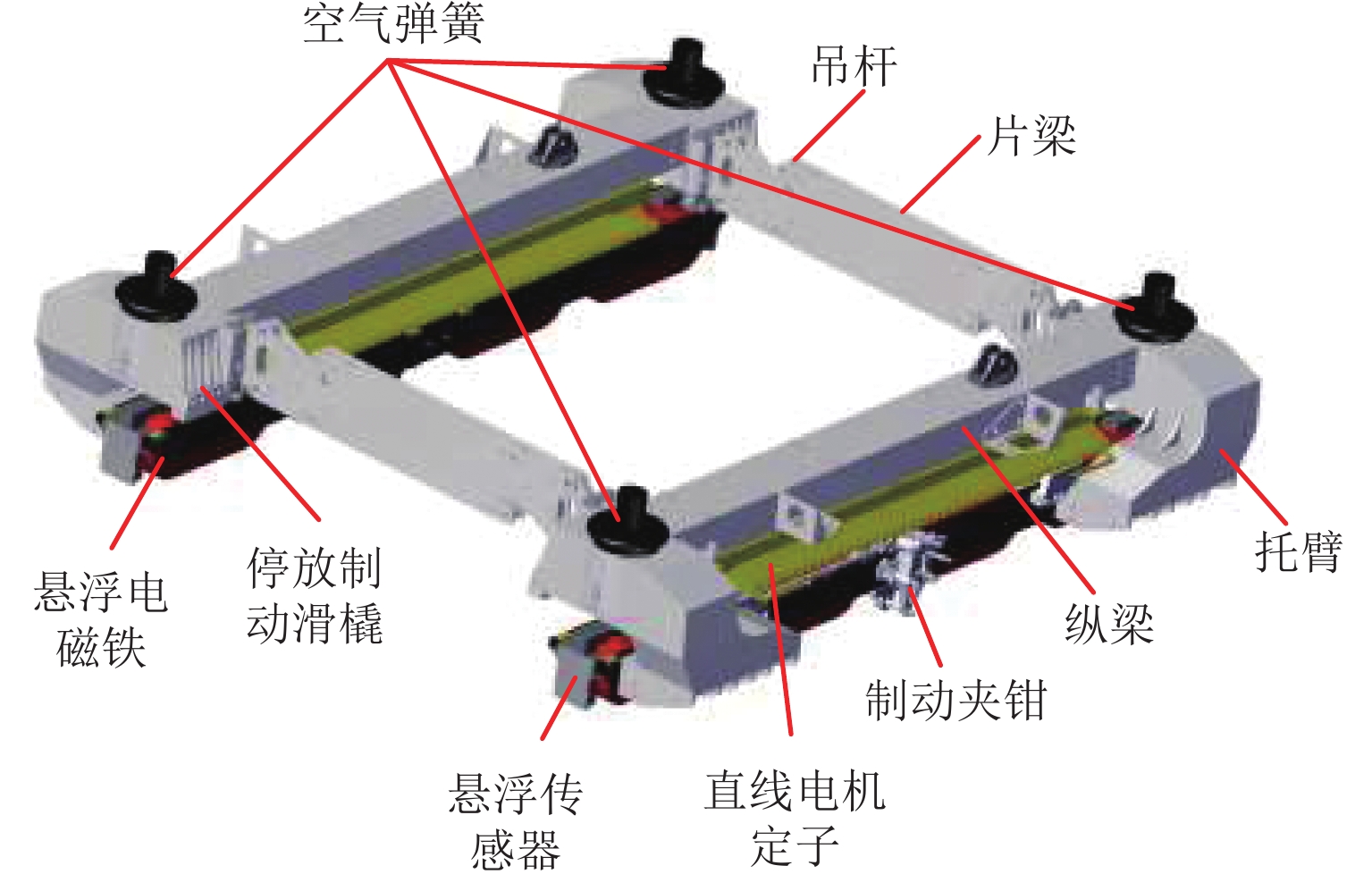
 下载:
下载:
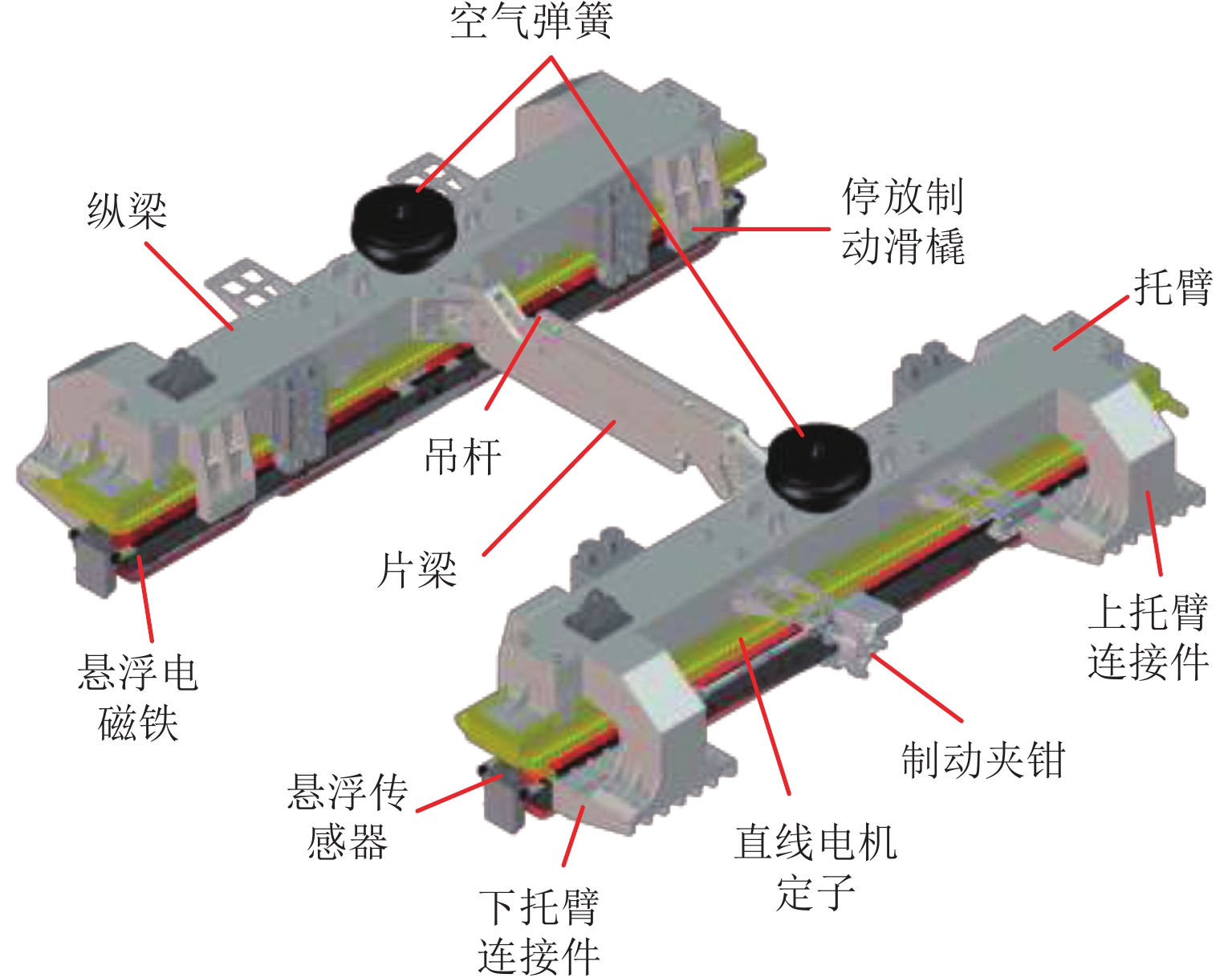


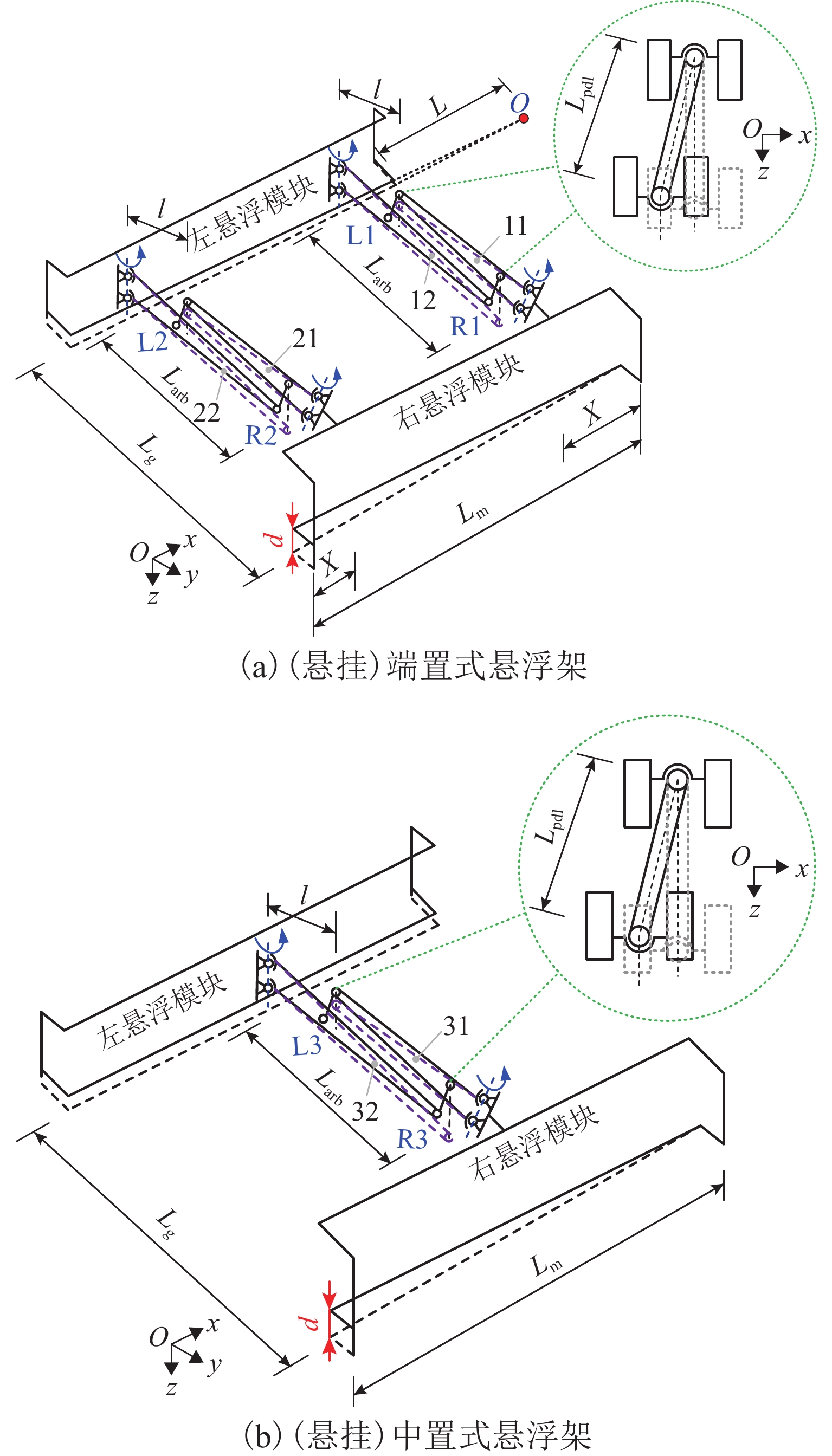

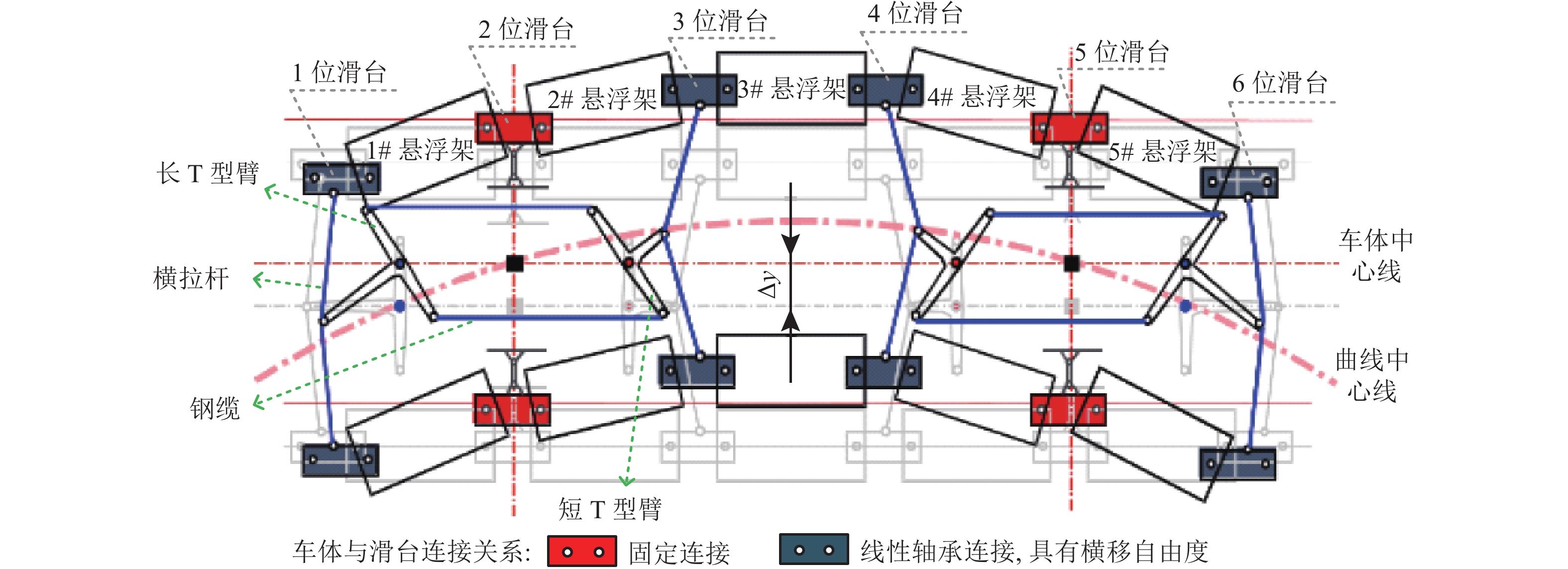

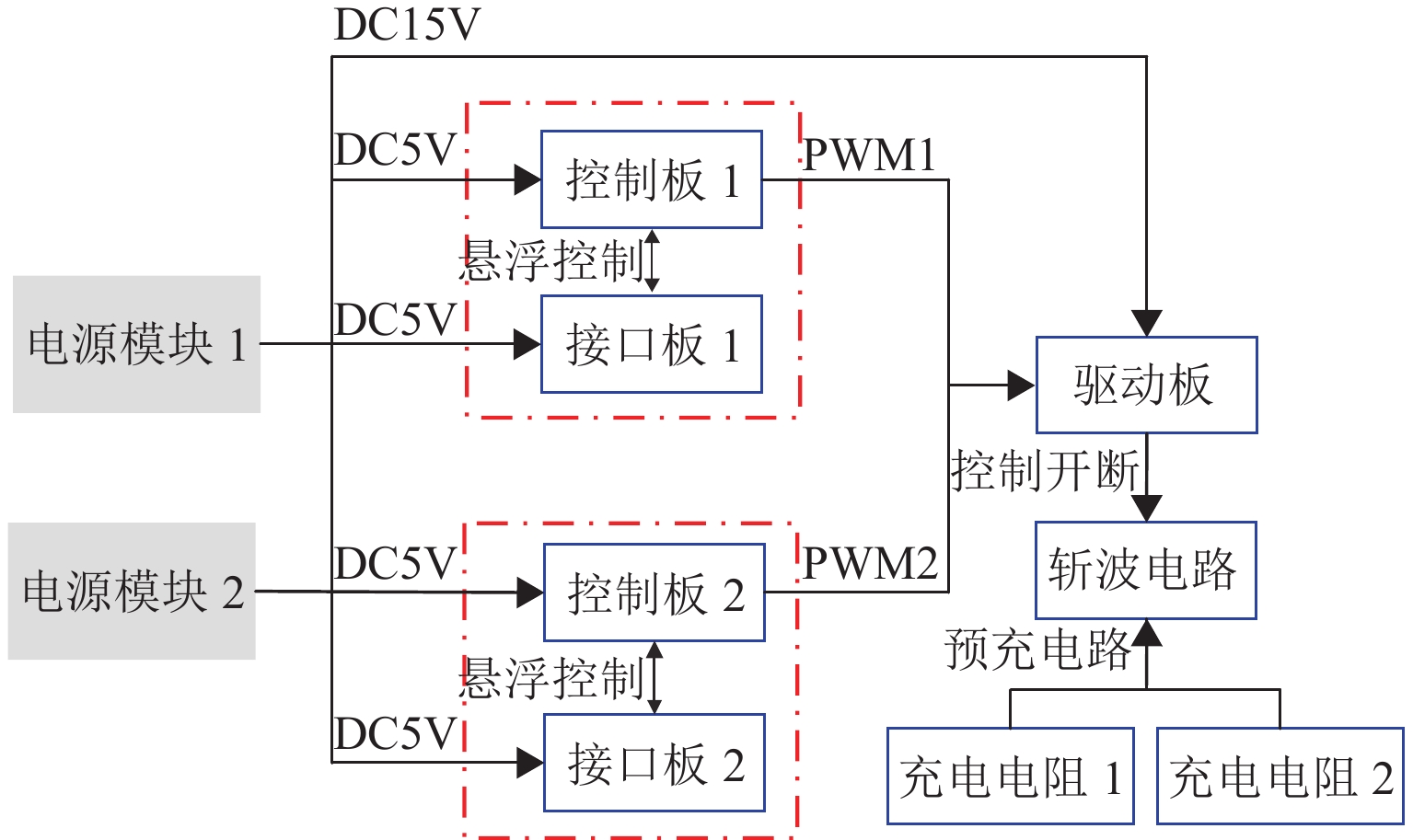
 百度学术
百度学术



